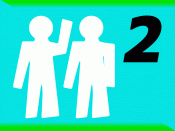Shortly after the announcement that British scientists had successfully cloned a sheep, Dolly, cloning humans has recently become a possibility that seems much more feasible in today's society. The word clone has been applied to cells as well as to organisms, so that a group of cells stemming from a single cell is also called a clone. Usually the members of a clone are identical in their inherited characteristics that is, in their genes except for any differences caused by mutation. Identical twins, for example, who originate by the division of a single fertilized egg, are members of a clone; whereas nonidentical twins, who derive from two separate fertilized eggs, are not clones. (Microsoftî Encartaî 97 Encyclopedia). There are two known ways that we can clone humans. The first way involves splitting an embryo into several halves and creating many new individuals from that embryo. The second method of cloning a human involves taking cells from an already existing human being and cloning them, in turn creating other individuals that are identical to that particular person.
With these two methods at our desposal, we must ask ourselves two very important questions: Should we do this, and Can we? There is no doubt that many problems involving the technological and ethical sides of this issue will arise and will be virtually impossible to avoid, but the overall idea of cloning humans is one that we should accept as a possible reality for the future. Cloning humans is an idea that has always been thought of as something that could be found in science fiction novels, but never as a concept that society could actually experience. Today's technological speed has brought us to the piont to where almost anything is possible. Sarah B. Tegen, '97 MIT Biology Undergraduate President states, "I think...



Cloning!
Really do not like the idea of cloning.Yet it is a controversial issue in bith the sciences as well as the social sciences.That humans can be cloned means that man wants to test God.
After all, man's attempt at cloning will not only be met with disaster but general world problem.What is even more, in spite of man's franctic interest in cloning, the first cloned had died in November, 2003
What more could be said,if dolly is dead would a cloned man not die? perhaps science can advance from here and project a decoration for the premptive clone man.Very well i would of course gladly applaude this writer,yet i find it difficult to understand why this work is so clustered.Don't uo know nothing about paragraphing?
Again, please tell me may be i did not remember,what is actually the view of this writer?
3 out of 3 people found this comment useful.